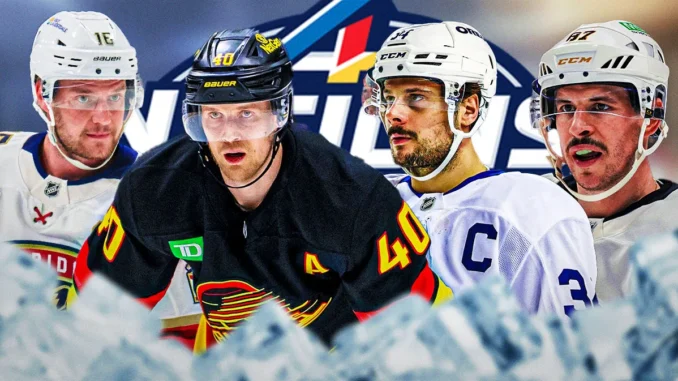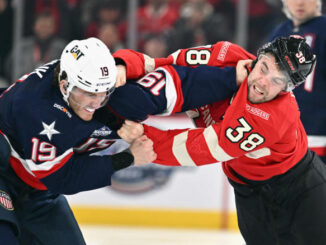
In lieu of the annual NHL All-Star Game, the league has organized the 2025 4 Nations Face-Off, which will feature Canada, the U.S.A, Sweden, and Finland facing off in a round-robin format, followed by a one-game final between the two top-placed teams. The event is set to run from February 12th–20th, and will be jointly hosted by Montreal and Boston.
The event is low on Seattle Kraken players (Finland’s Kappo Kakko is the team’s lone representative), but that doesn’t mean that fans have little to look forward to during the two-week break from NHL hockey.
The tournament marks the first time NHL players have played in a major international showcase since the 2016 World Cup of Hockey. Players show up for the annual IIHF World Championship, but the event rarely houses the NHL’s best, as it usually takes place during the first round of the playoffs. For now, the event appears to be a test run for future NHL-run events and a precursor to NHL players playing in the Winter Olympics for the first time since 2014.
Without further ado, let’s dive into several of the biggest storylines to watch at the 2025 4 Nations Face-Off.
Canada-U.S. Rivalry Renewed
Apart from one notable blip at the 2006 Winter Olympics in Torino, Canada dominated international hockey during the first quarter of the 21st century. Sweden (2006 Winter Olympics) is the only other country to win a major international tournament since 2002, with Canada winning all six of the remaining events.
| Event | Canada | USA |
| 2002 Winter Olympics | Winner | Runner-Up |
| 2004 World Cup of Hockey | Winner | 4th |
| 2006 Winter Olympics | 7th | 8th |
| 2010 Winter Olympics | Winner | Runner-Up |
| 2014 Winter Olympics | Winner | 4th |
| 2016 World Cup of Hockey | Winner | 7th |
Canada directly knocked off its neighbors to the south in two Olympic finals (2002 and 2010), with the latter setting the stage for one of the sport’s most iconic moments – Sidney Crosby’s “Golden Goal” to win the game in overtime.
While it is not a direct commentary on the state of senior men’s hockey, the IIHF World Junior Championship offers a glimpse into the future. The tournament’s recent results suggest that the balance of power may be shifting.
Canada holds the record with 20 titles, while the USA – the current back-to-back champions – sit third all-time in golds (seven and total medals (16).
Since the end of Canada’s recent five-year run of dominance (2005-2009), the USA has won the event six times to Canada’s five, while accumulating more medal finishes (11 vs. 10) than their neighbours to the north. More surprisingly is that Canada has finished fourth or lower in six of the 16 tournaments since 2009, while the U.S. has only failed to medal in five of the last 16.
The U.S. has also defeated Canada in the final three times since 2009. The most painful of the three (2010, 2017, 2021) was during the 2010 edition, in which the U.S. ended Canada’s quest for an unprecedented six consecutive tournament wins by beating them in overtime. While the unfulfilled bid for history was painful enough, Canada had forced overtime by erasing a two-goal lead in the final three minutes of regulation, making John Carlson’s overtime winner all the more tortuous.
In hindsight, the 2010 event appears to have marked the end of Canada’s reign over the sport. While they have won all three of the biggest senior tournaments in the 15 years since, Canada is seeing their status as a global hegemon diminish due to deep-rooted issues at the grassroots level. The U.S. has bridged the financial gap between the two nations in terms of funding the sport, and has always had the advantage of a much bigger population and recently surpassed Canada in total youth hockey participation.
While the Canadians can still count the league’s best players among their ranks for the time being (Connor McDavid, Nathan MacKinnon, Cale Makar, Sidney Crosby, etc.), the 2025 4 Nations Face-Off could be a tipping point in the balance of power. The American’s growing dominance at the junior level should continue to bear fruit, with Auston Matthews, Matthew Tkachuk, and Charlie McAvoy (among many others) being the by-product of that investment.
Can Canadian Goaltending Hold Up?
One worrying trend that has permeated the Canadian roster-building ethos is the lack of all-star-caliber goaltenders being developed north of the 49th parallel. Take a look at the starting and backup goaltenders that Canada has used since 2002.
| Event | Starter | Backup |
| 2002 Winter Olympics | Martin Brodeur | Curtis Joseph |
| 2004 World Cup of Hockey | Martin Brodeur | Roberto Luongo |
| 2006 Winter Olympics | Martin Brodeur | Roberto Luongo |
| 2010 Winter Olympics | Roberto Luongo | Martin Brodeur |
| 2014 Winter Olympics | Carey Price | Roberto Luongo |
| 2016 World Cup of Hockey | Carey Price | Corey Crawford |
Of the five goaltenders who have played at least one game during those six tournaments, two have been inducted into the Hockey Hall of Fame (Brodeur and Luongo), one is a shoo-in after he officially retires (Price), one is a borderline case who has been passed over multiple times (Joseph), and one is a borderline case who may be ignored due to playing behind the recent Chicago Blackhawks dynasty (Crawford was the starting goalie for two of their three Stanley Cups since 2010). Those five netminders have five Vezina Trophy wins between and 10 collective nominations to the NHL’s year-end First and Second All-Star teams.
Beyond the five goalies who played, Canada could also count on the likes of Ed Belfour, Marty Turco, Marc-Andre Fleury, Mike Smith, Jose Theodore, and Braden Holtby to provide incredible depth beyond the entrenched starters. Hall-of-Fame netminder Patrick Roy (who was Canada’s starter for the 1998 Olympics) declined the opportunity to play for Canada at the 2002 edition, and the team still won gold.
All that is to highlight how Canada has struggled to develop their next generation of goaltenders for a multitude of reasons. The next three NHL draft classes should pull the brakes on that worrying trend with nearly all of the top goaltending prospects hailing from the Great White North, but that doesn’t help Canada for the 4 Nations Face-Off, or the 2026 Olympics.
Given how early the deadline was to name the rosters (beginning of December) for a tournament three months away, there have been some discussions about how Canada may not have named any of their three best goalies for the event.
Jordan Binnington (.896 save percentage), Adin Hill (.900), and Sam Montembeault (.897) have a pair of Stanley Cups between them, but none of the three are among Canada’s five best goaltenders by SV% this season (minimum 15 games played). Logan Thompson (.921), Darcy Kuemper (.919), and Mackenzie Blackwood (.917) are currently Canada’s three best goalies in this regard and barring a last-minute injury, none of the three will be representing their country this time around.
Although Russia and its world-best goaltending depth (Vasilevskiy, Bobrovsky, Sorokin, Shesterkin) will not be at the event for geopolitical reasons, each of the U.S., Sweden, and Finland should arguably rank ahead of Canada in the netminding department for this tournament.
The Americans can count on Connor Hellebuyck (two-time Vezina winner), Jake Oettinger, and Jeremy Swayman (the trio is second, ninth, and 12th in SV% since 2022-23 respectively; minimum 41 games played). Sweden has Linus Ullmark (2023 Vezina winner) and Filip Gustavsson (top-10 in SV% this season. Finland has Juuse Saros who has finished sixth or better in Vezina voting in four consecutive seasons.
No country can match Canada’s star power, with six Hart Trophy wins spread between MacKinnon, Crosby, and McDavid since 2007. That trio – along with defenseman Cale Makar – have also won four of the last nine Conn Smythes as playoff MVP. Whether that is enough to overcome the sizable talent deficiency in the crease will be the biggest storyline of the tournament, especially since every other country will be bringing All-Star-level skaters of their own.
Can Finland or Sweden Pull Off an Upset?
All this talk about Canada and the US has left the tournament’s other two contestants – Finland and Sweden – by the wayside. It’s not necessarily fair, but it’s a reflection of the two country’s recent results on the international stage and their lineup depth beyond their leading stars.
As mentioned earlier, Sweden is the only other country to win a major international tournament in the 21st century in which NHL players took part. The 2018 (Olympic Athletes from Russia) and 2022 Winter Olympics (Finland) were widely celebrated by the winners, but they don’t hold much weight globally as the world’s best players were not in attendance.
Finland is led by a three-headed monster upfront of Mikko Rantanen (fifth-most goals since 2022-23), Sebastian Aho (28th in points-per-game since 2022-23), and Aleksander Barkov (16th by points-per-game and captain of the 2024 Stanley Cup champion Florida Panthers).
Finland’s chances of winning the tournament dropped precipitously after it was announced that Norris-caliber defenseman Miro Heiskanen would miss the event after being injured on a dangerous hit by Mark Stone in late January. They will have to rely on their remaining stars and goaltender Juuse Saros (fifth in cumulative GSAx over the past five seasons). If those four do not perform, they will finish at the bottom of the table.
On the other hand, Sweden is better equipped to topple the Canada-U.S. duopoly. They will have the option of relying on one of Ullmark Gustavsson in net. William Nylander is second in the league in goals (33), and also one of three Swedish forwards to be scoring at a point-per-game clip or better this season (Lucas Raymond and Jesper Bratt).
Sweden also has the benefit of trotting out arguably the best defensive core in the tournament, though its key figures are on the back-nine of their careers.
Victor Hedman (2019 Norris; 2020 Conn Smythe) and Erik Karlsson (2012, 2015, and 2023 Norris winner) are the biggest names, but both are 34 years old. 24-year-old Rasmus Dahlin is the heir apparent on the Swedish blue line, ranking seventh among all NHL defenders in points since the start of the 2022-23 season. Rounding out the formidable seven-man group are Gustav Forsling, Mattias Ekholm, Rasmus Andersson, and Jonas Brodin, a collection of some of the league’s best two-way rearguards.
Though Dahlin is the only Swedish defenseman under the age of 25, the country’s greybeards still play key roles on some of the NHL’s best teams, and are comfortable with facing elite competition. If Sweden recreates its surprise win from 2006, it will be because of the team’s sturdy defensive backbone.
4 Nations Face-Off Marks Return of NHL to International Hockey
Despite all the legitimate criticisms of the 4 Nations Face-Off regarding limited involvement from other countries as well as the NHL’s perceived challenge of and uncoupling from the International Olympic Committee, fans should be excited about the tournament. It marks the first time NHL players have participated in a best-on-best event since 2016 and indicates that the league will allow its players to play in the 2026 and 2030 Winter Olympics (and hopefully beyond).
Hockey as a sport lags behind football, basketball, and even soccer in North America and if commissioner Gary Bettman wants to burnish his legacy before retiring from the NHL, these types of tournaments are sorely needed. The lack of Olympic participation has been a missed opportunity for increasing the sport’s cultural relevance and securing its future in a more perilous global financial environment. The tournament may not be perfect, but it is important.
Data courtesy of Evolving Hockey, Natural Stat Trick and the NHL.


